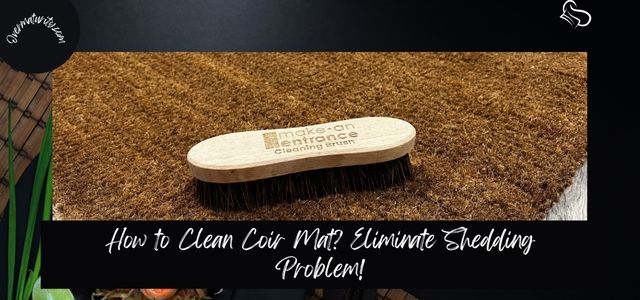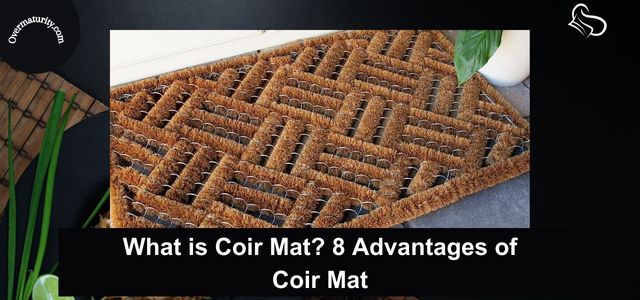Coir is famous for doormats and rugs. Coir mats or coconut fiber are becoming more popular as an environment-friendly choice for workplaces, schools, and other business locations. They are a long-lasting and stylish addition to your home that is easy to care for and ecologically safe.
It gives your commercial premises a warm tropical elegance and vintage sophistication. It is adaptable, so you’re not limited to utilizing it simply for your entrance, but you can also use it as a wall-to-wall area mat, in recessed wells, or as stair runners. They lend themselves to all of these purposes well.
Furthermore, these coir mats may be customized with logos and branding. Yet another reason to purchase them is for your commercial locations. However, as with any mat, you must clean it regularly to ensure a perfect presentation. Many buddies are confused about cleaning coir mats; if you are too, hold on, this article “How to clean coir mat” is for you. It contains the information that you are looking for.
Why Should You Clean Your Mat?
Clean your mat correctly regularly to avoid germs and unpleasant odors. Cleaning does not kill germs, but it does remove them from a surface, along with dirt and pollutants. Consider sanitizing your mat to destroy bacteria and avoid the spread of infection. Coir mat is made up of coconut fibers.
When selecting a doormat, look for simple to clean and effectively eliminate debris from shoes and paws. Before entering your home, make sure it’s long enough to walk on with both boots.
The Material Used in Construction
Most commercial coir mats have a vinyl backing that helps them keep their shape, lasts longer, and is easier to clean. Like any other type of mat, Coco mats need proper maintenance to survive as long as possible and maintain their attractive appearance. We’ll go through how to care for and preserve vinyl-backed coco mats in this post.
1. Mat Made of Coconut Husk
Coir mats and rugs are made from coconut husk. Coconut husk includes elasticity and is sturdy and resilient, making it an excellent choice for high-traffic carpets. Daily use of your coir carpet will cause dirt, dust, and debris to become trapped in the fibers, just like any other form of carpeting. Your mat will appear worn and dingy as a result of this. Coir carpets are easy to clean due to their resilience. To avoid shrinkage, it is advisable to clean them with a dry powder instead of a liquid cleaning solution.
2. Mat Made of Black Coir
During the winter months, mud, snow, and damp shoes are more likely to be tracked across coir mats. You’ll want to get rid of as much clear debris as possible. To do so, hang the carpet up and beat it with a broom handle to remove most of the dirt trapped inside. Because this is a dusty job, make sure you perform it outside.
If dirt remains, clean any remaining dirt patches with water and a stiff brush before drying naturally because coir is a very adaptable substance with antibacterial and antifungal properties. It can endure the effects of water, salt, and heavy footfall, especially if you take the time to clean it regularly. Cleaning of the coir mat is divided into regular or in-depth cleaning; you can clean as per your choice and need.
How to Clean Coir Mat?
Cleaning a coir mat is a straightforward process that involves a few key steps. Take preventive measures by placing a doormat outside the entrance, regularly shaking or beating the mat, utilize a vacuum cleaner. For stubborn stains, spot clean with a mixture of mild detergent and water, then rinse and air dry. Below is the details process to get better results.
1. Preventive Measures: To minimize the amount of dirt and debris brought onto the coir mat, place a doormat outside the entrance as well. This will help scrape off larger particles before stepping onto the coir mat.
2. Dry Cleaning: Regularly shaking or beating the coir mat is an effective way to remove loose dirt and dust. Doing this outside will prevent the debris from spreading inside your home or business premises.
3. Vacuuming: Use a vacuum cleaner with a motorized head and brushes to effectively remove embedded dirt and debris from the coir mat. Vacuuming should be done regularly, ideally, once a week, to maintain the mat’s appearance and performance.
4. Spot Cleaning: For stubborn stains or spills on the coir mat, you can spot clean using a mixture of mild detergent and water. Gently scrub the affected area with a soft brush or cloth, then rinse with clean water and allow it to air dry.
Note: Coir mats, especially new ones, may shed some fibers initially. This is a natural characteristic of coir. Regular vacuuming can help reduce shedding and keep your floors clean from loose fibers. Coir mats should generally be cleaned with dry cleaning methods or spot cleaned with minimal moisture. Excessive use of liquid cleaning solutions may cause the coir fibers to shrink or deteriorate over time. Permanent discoloration can be caused by hot liquids, bleaches, and goods containing natural colors, such as curry, mustard, herbal tea, and so on.
How to Wash Your Coir Doormat
Your doormat needs to work extra hard during the rainy and chilly months. Mud, salt, and snow are regularly scraped off the door, putting your coir doormat to the test. It’s critical to understand how to properly care for your coir doormat so that it lasts for many years.
- Before cleaning a coir doormat, scrape off as much apparent dirt and debris as possible. You can utilize a tool if necessary.
- Outside, hang the coward and beat it with a broom handle or something like that. Because there may be a lot of dirt caught between the threads, do this over grass or dirt rather than your driveway or porch.
- Remove any leftover dirt particles with water and a stiff-bristled brush. Finally, dry your doormat by placing it on a level in the sun.
- In general, a basic shaking approach should be used to clean your doormat once a week. If you currently sweep your porch regularly, make this a habit. Take the coward and toss it around on your grass.
- You can also vacuum the mat to remove any remaining debris. Check your doormat once a month to ensure it’s still in good shape. At least once a season, you should follow these recommendations.
A Dry Coir Mat Cleaning
A shakedown of the coir mat will remove the vast majority of dust and dirt. This will also give you the chance to provide the floor around the carpet a good clean and the mat well if it is a recess coir mat. Once most of the dust and dirt has been shaken out, vacuum the mat to hoover up any excess debris. As a more eco-friendly option, coir mats are growing in popularity for offices, schools, and other business locations to use in their doorways. Still, they are best used in dry conditions where they are more effective and long-lasting.
Keeping Your Coir Mat from Shedding
Coir doormats have a natural appearance and give an excellent surface for scraping shoes; but, because the material is raw, it is prone to shedding, especially in the first few weeks of use. Higher-quality coir mats do not shed as much as lower-quality coir mats and coir strands may free from the mat with bristles that subsequently spread around the floor, making it look untidy.
A mat well or recessed coir mat can help with this since the edges of the mat are secured and held in place, unlike a loose-lay coir mat. The bristles will be trapped in the area where they will be vacuumed. Hoovering your coir mat regularly will extend its life and eliminate any shedding difficulties.
The Benefits of Coir Rugs and Carpets
Coir objects are exposed to a lot of foot traffic; they must withstand wear and tear. Coir is naturally water-resistant, making it great for doormats, particularly those kept outside. Coconut oil, which is naturally contained in coir, repels insects and prevents mold formation.
Coir’s natural appearance is especially appealing for outdoor application, where it pairs well with rustic designs, brick, and lumber. It’s also cheaper than a lot of other natural flooring options. Coir is a popular eco-friendly alternative because it is biodegradable and originates from renewable sources. The best part is that it requires very little upkeep. To stay in good shape, it only has to be cleaned once in a while.
Conclusion
Coir is an eco-friendly alternative to a variety of home needs. Its coarse and stiff fibers make it a good choice for doormats, rugs, and carpets because they are naturally tough and durable. Coir mats are an excellent choice for sustainability and lifespan because of their antibacterial and antifungal properties, as well as their inherent defense against water, stress, and salt. It’s usual for this coir mat to lose fibers in the first few weeks. Proper cleaning is necessary, so you can brush or shake the mat regularly to keep it looking good and to keep dust and filth away.



